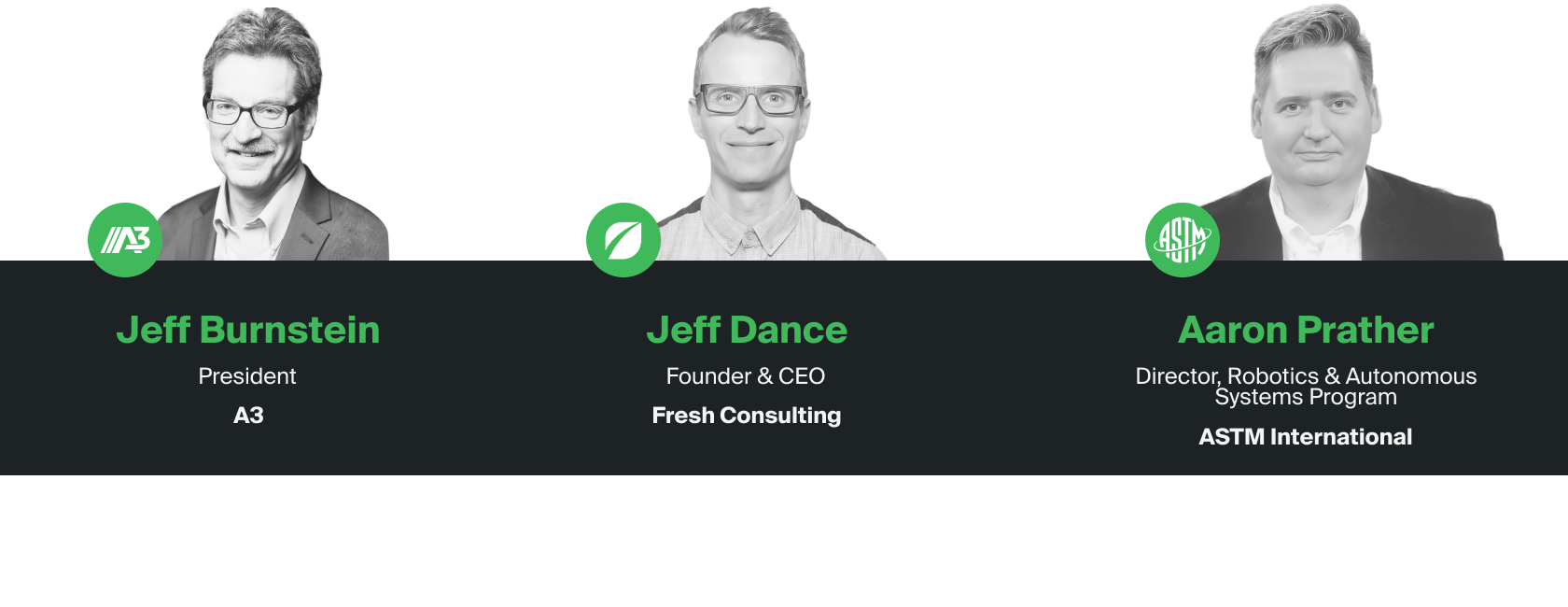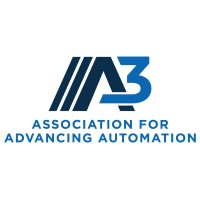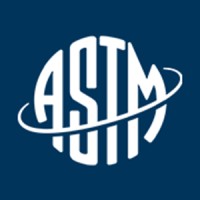The
Future Of Human-Robot
Integration
Jeff Burnstein, President of Association for Advancing Automation, and Aaron Prather, Director of Robotics and Autonomous Systems Program at ASTM International, join Jeff Dance to discuss the future of human-robot integration.
Jeff Burnstein, President of Association for Advancing Automation, and Aaron Prather, Director of Robotics and Autonomous Systems Program at ASTM International, join Jeff Dance to discuss the future of human-robot integration.
In this episode of The Future Of, Jeff Burnstein, President of Association for Advancing Automation, and Aaron Prather, Director of Robotics and Autonomous Systems Program at ASTM International, join Jeff Dance to discuss the future of human-robot integration. They cover topics such as job displacement fears, the importance of standards and safety, the potential for meaningful work in the future, and the exciting potential of robotics and AI in various industries and their integration with humans.

With over thirty-five years of experience, Jeff Burnstein has dedicated his career to advocating the utilization of robotics, machine vision, and motion control. He firmly believes that automation is revolutionizing every aspect of our lives, bringing about positive changes. Through automation, new and improved job opportunities are emerging while providing us with higher-quality products at more affordable prices. Additionally, Jeff sees the potential for automation to contribute to our longevity and overall well-being, promising to assist us in living longer and healthier lives.
Aaron Prather plays a pivotal role in Robotics Standardization, Training and Certification, and R&D efforts. Building upon his extensive background of over twenty-five years at FedEx, where he began as a materials handler and later served as a senior technical advisor and R&D evangelist, Aaron brings a wealth of knowledge and expertise to his current position. During his tenure, he actively engaged in projects involving cutting-edge technologies such as robotics and AI, consistently striving for advancements and innovation.
The Growing Integration of Humans and Robots
The integration of humans and robots encompasses various aspects beyond physical machine integration, such as biohacking. It involves the collaboration and coexistence of robots and humans in shared spaces. In the past, robots were separated from us, confined behind fences. However, as robots become more integrated into our daily lives, we will interact with them more frequently, using them as tools to help us in our daily tasks.
Wearable robots, for instance, are emerging, enabling robots to be attached to the human body. This raises questions about how such augmentation affects humans. Exoskeletons, for example, may involve the robot assisting in the movement of the person. Additionally, concepts like the Dr. Octopus suits are becoming a reality in some areas, highlighting the substantial intersection between humans and robots.
Transforming Robotics
Historically, one of the burdens faced by companies was the lack of ease of use in robotics. Many found it too complex, expensive, or simply not suitable for their needs. However, the industry has made significant progress in addressing this challenge by developing user-friendly, out-of-the-box solutions that can be quickly implemented. With the advent of low-code and no-code approaches, users no longer require extensive internal engineering operations to adopt robotics. While system integrators are still needed in some cases, there is a growing trend toward simplified setup processes. This emphasis on ease of use is crucial as various industries seek to automate their operations.
Another important topic of discussion is the impact of AI, including technologies like ChatGPT and Machine Learning. Finally, there is a shift in perception regarding the accessibility of robotics and automation, which were once perceived as exclusive to large corporations like General Motors. Now, even small and medium-sized companies realize that with the simplicity demonstrated in some applications, almost anyone can succeed by starting with the right use cases.
Embracing Robots: A Catalyst for Job Creation and Business Expansion
The initial fear that robots would eliminate jobs in the US automotive industry did result in significant job losses when the robot industry faced a downturn. However, the real threat to jobs arises when companies can’t compete, putting all jobs at risk. In the past two decades, we witnessed a substantial shift of US jobs to Asia due to the pursuit of cheap labor. Ironically, China, now the world’s largest robotics user, relies on robots to maintain its manufacturing dominance. This strategic focus on robotics allows them to excel in quality, delivery speed, and productivity.
Despite concerns about replacing jobs, history has shown that technologies enhance productivity, create new jobs, and offer better pay and safety. For instance, in the warehouse industry, technology frees workers from physically demanding tasks, enabling them to engage in more fulfilling roles that utilize their skills. Similar to the banking sector, where the introduction of ATMs led to more job opportunities for bank tellers as automation took over mundane tasks, robots serve as tools that expand businesses and open up new possibilities. Fortunately, more people are beginning to understand this perspective and recognize the potential of robots in job creation.
Prioritizing Robot Safety Standards
In the robotics industry, everyone must stay updated on robot safety standards, supported by the Association for Advancing Automation and ISO. Being actively involved and well-informed about these standards is essential because ensuring robot safety is a fundamental pillar of our industry. It is vital to prevent robots from causing harm to humans, addressing the fears people may have. Decades of dedicated work have resulted in excellent safety standards that prevented incidents involving robots and humans.
Additionally, achieving interoperability between robots is crucial, and organizations like Mass Robotics in Boston are making significant progress in this area. Our challenge lies in establishing harmonious standards among different groups to avoid conflicts. Furthermore, developing performance standards and testing mechanisms becomes essential as robots transition from factories to public spaces. Industries governed by their own standards, separate from ISO safety standards, require support in adopting existing frameworks.
Advancements in Service Robots
The concept of service robots has been a topic of discussion lately, envisioning their potential to handle various tasks in our daily lives, including elder care. Joe Engelberg believed that multipurpose robots could assist us with undesirable chores at home, similar to how they are employed in factories and warehouses for cleaning and other tasks. While we haven’t fully achieved this vision yet, there is a growing need for assistance among individuals who are mentally capable but require help due to physical limitations, such as getting up from a chair or moving around their living spaces.
Although we still have a long way to go, we are making gradual progress in this field. The logistics industry has already demonstrated the effectiveness of mobile robots on a large scale. With the emergence of autonomous mobile robots in warehouses and factories, we are witnessing their application in various settings. For example, robots in hospitals can transport supplies from storage areas to nurses, allowing them to remain near their patients. Similarly, in restaurants, waiter robots are responsible for delivering food to tables, while the human waitstaff attends to other aspects of service, ensuring a seamless dining experience.








